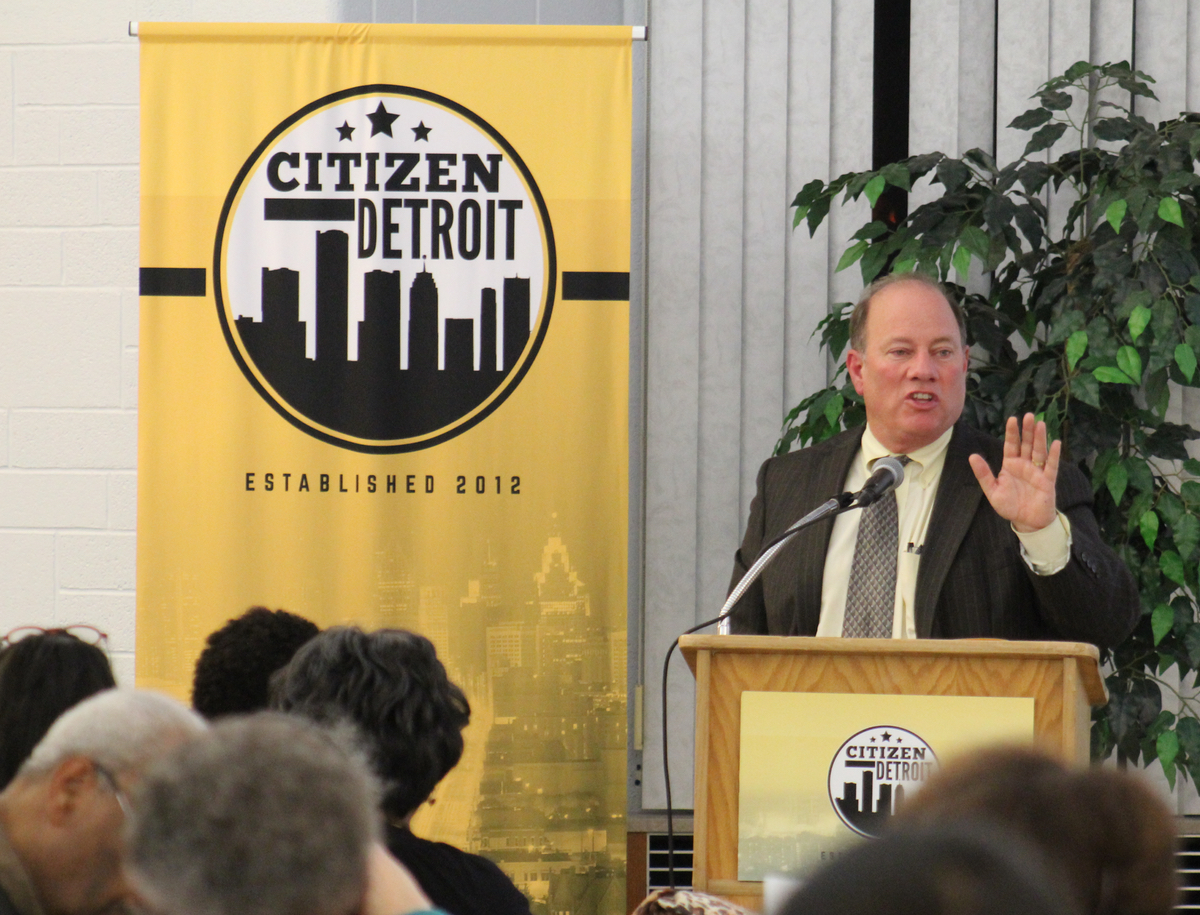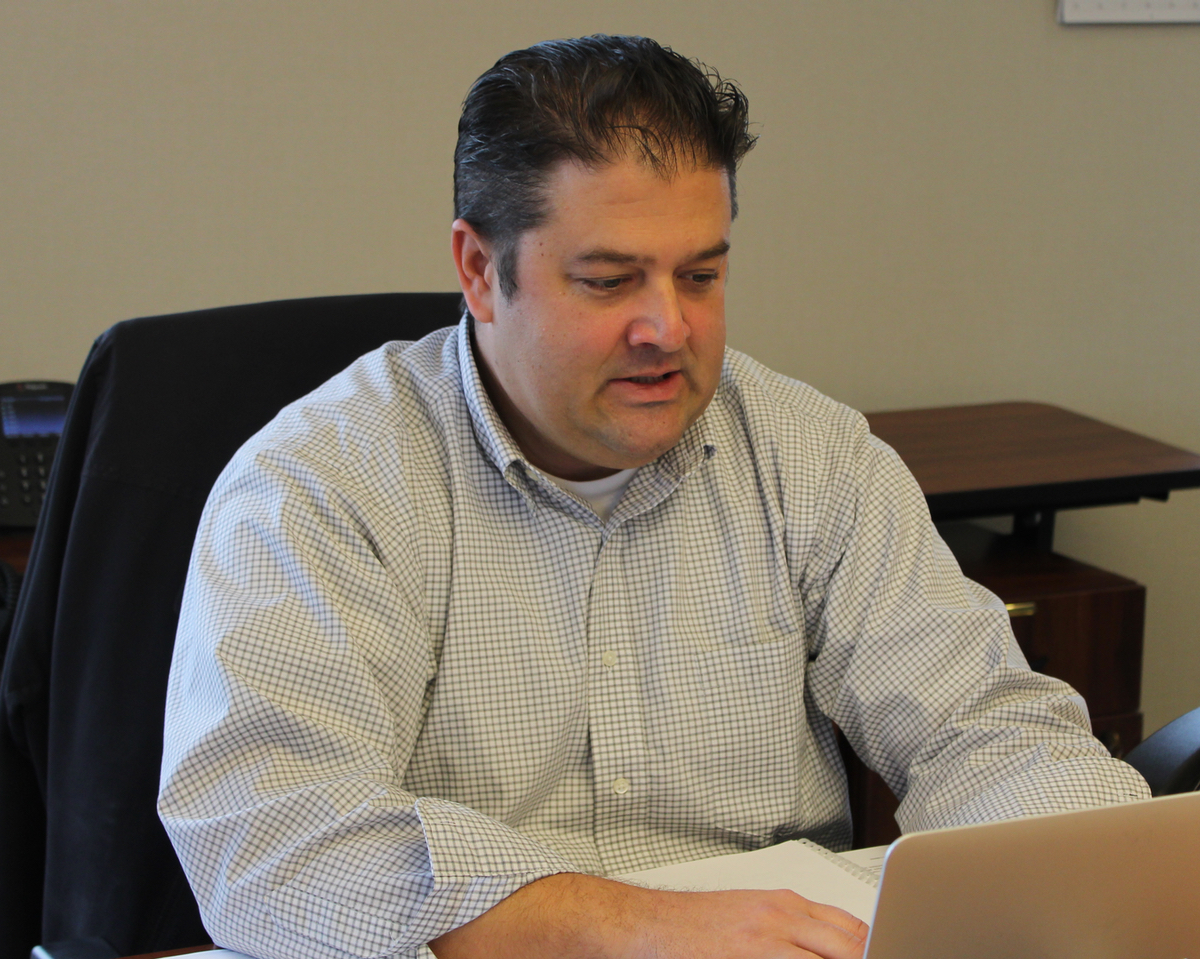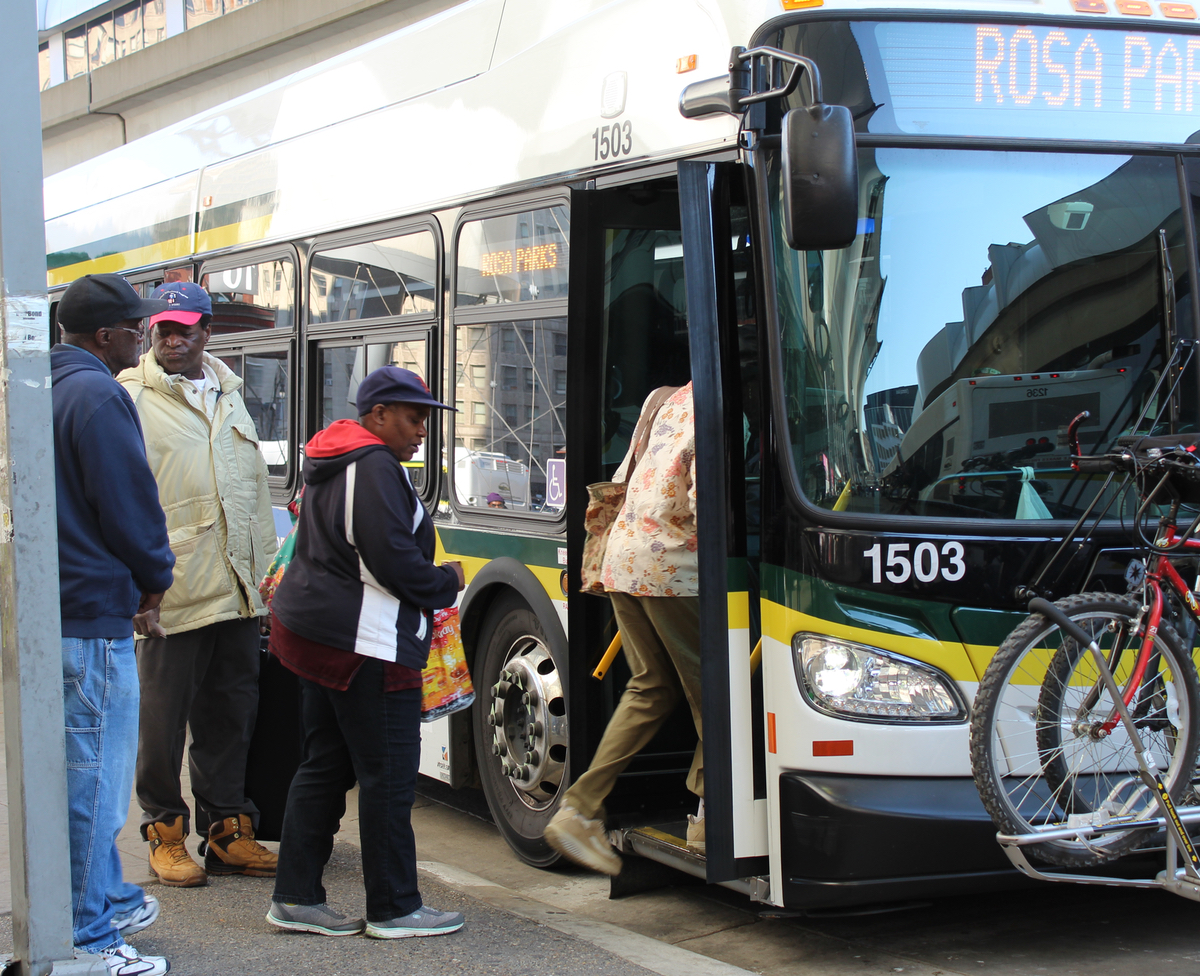A year post-bankruptcy, Detroit still has a long to-do list
To Mayor Mike Duggan, at least publicly, Detroit post-bankruptcy is nothing but blue skies ‒ with a few clouds that cast occasional shadows over the sprawling city. To the head of the city’s firefighters union, it’s a time of “all-time low” morale for the city’s workforce, insulted by cuts to pensions and forced health care payments.
Optimistic residents look forward to better times, while others worry that ordinary Detroiters and ordinary neighborhoods will be forgotten in the crowing over rebirth and success in the central business district.
It was one year ago that the historic bankruptcy deal shed about $7 billion – roughly 40 percent – of the city’s long-term debt, largely through reductions to pensions and retiree health care. It brought an infusion of money to shore up the pension funds in exchange for preventing the sale of the city-owned collection at the Detroit Institute of Arts to pay creditors. Legislators agreed to send state money to pension funds in return for oversight panels monitoring the city’s finances. Unions accepted five-year contracts and retirees voted for the deal, accepting terms that prevented them from challenging it in courts.
So how is the bankruptcy settlement, crafted under now-retired bankruptcy Judge Steven Rhodes, holding up after a year? The Detroit Journalism Cooperative investigated, concentrating on deals and settlements; residents, employees and pensioners; and the bankruptcy’s potential impact as the city goes forward.
“Streetlights are being replaced. More buses are running. Parks are being mowed and maintained,” Duggan told the city’s Financial Review Commission this fall. And for a city that is often in need of emergency responders, “the ambulances are arriving within eight or nine minutes which is the national standard so we have a lot of things that are a lot better.”
Other public safety response times are more complicated; Detroit Police Chief James Craig and Duggan say emergency response times are down sharply – from the 58-minute figure Emergency Manager Kevyn Orr quoted at the beginning of the bankruptcy case to the roughly 15-minute average police response time that city officials now tout (A recent Bridge analysis found that the 58-minute figure was likely an exaggeration, and that part of the response-times drop was accomplished by reclassifying some calls as lower-priority).
On the financial side, John Naglick, Detroit’s finance director, said it’s too soon to give a thorough overview of the redrawn financial picture, and that tweaks to the Plan of Adjustment – the bankruptcy court-approved blueprint for post-bankruptcy finances – are inevitable and ongoing, mainly in the area of pensions, through adjusting actuarial tables for pension planning. But discharging the city’s bonded indebtedness, assumed under the administration of then-mayor Kwame Kilpatrick, left much-needed breathing room.
“It’s allowed us to take money that used to have to go to things that weren’t visible to the citizens and people that come to the city to do work, and allowed us to put a lot more resources toward improving police and fire,” as well as hiring new workers to deliver much-needed services, Naglick said.
Major challenges remain on the administration’s agenda, and Duggan ticks them off – sky-high car insurance rates, failing schools and high unemployment for city residents. Not all are in his power to change.
But to Duggan, even for a city that had nowhere to go but up, the trajectory and progress of the climb has been satisfying.
Others are less enthusiastic. Jeffrey Pegg, president of Detroit’s firefighters union, said departmental morale is “at an all-time low,” due to stagnant pay and closed firehouses, as well as other, more profound changes.
“Look, the city has to come back, and it will come back, and it is coming back,” Pegg said. “It’s just very difficult when you sit in meetings that say the reason we got new fire trucks is because they cut retiree health care. ...What about the people that worked for the city that put their lives on the line?”
Shirley Lightsey, president of the Detroit Retired City Employees Association, calls for pensioners and residents to take responsibility for their own destinies. The retired human resources administrator in the water and sewerage department said voting has never been more important.
“I think we have to be a lot more thoughtful and serious as to who we put in office. So if nothing else, get out and vote,” Lightsey said.
Deals and settlements
Detroit’s historic municipal bankruptcy was, in the end, a negotiation. No one walked away from the fiscal wreckage of the old Detroit with everything they wanted; the reorganization of the city’s assets and obligations left everyone involved with wins and losses.
The parties cover a dizzying spectrum, from Wall Street bond insurers to elderly retirees to residents of the city itself, who had been living on dark streets, standing on corners waiting for police cars and buses that came late if they came at all.
The city won some fiscal stability, albeit with new oversight and other terms. But most parties lost financially and still describe the bitterness.
Art lovers may have gotten the sweetest piece of the pie.
The DIA’s collection, the crown jewel at the top of the asset sheet, was preserved, its assets protected from sale to pay debts. It was the centerpiece of the so-called grand bargain negotiated by Chief U.S. District Judge Gerald Rosen, who acted as chief mediator in the case. The art was essentially leveraged for $816 million, contributed by the state, local foundations, some private businesses, labor unions and the DIA itself. The money is being used to at least partially protect the pensions of city retirees.
Delivering those works of art to the safety of a newly formed nonprofit ‒ separate from the city and protected from present and future claims ‒ seemed to ease the whole settlement process.
“I have called that settlement and (Rosen’s) work on the case in that settlement miraculous and I stand by that,” said Rhodes.
Other deals weren’t so sexy, though they touch millions of people in Michigan.
The Great Lakes Water Authority, a city-suburban organization that will oversee water and sewer services to most of the southeast Michigan region, also came out of the bankruptcy settlement. It put together a complicated deal for parties that have not always played well together in the past, and all hope the new regional authority will both protect vital infrastructure and offer some relief to impoverished homeowners who cannot pay their water bills.
For the city’s pensioners ‒ many elderly, unable to return to work and entirely reliant on their pensions ‒ the grand bargain left their monthly checks only 5 percent lighter. But they won’t get any more cost of living increases, and the biggest hit came in healthcare, essential to the elderly. The city slashed its obligation to fund retiree health care by 90 percent, leaving those affected to find their own solutions.
William Davis, a Detroit Water and Sewerage retiree, puts it this way: “The whole thing was just wrong and as far as we’re concerned it was illegal.”
Police and firefighters have a separate system, and endured less pain than general retirees, but health care for them, too, will be more expensive.
Residents had, in many cases, nowhere to go but up. And life has improved for many.
“I think that the bankruptcy has shined a light on the city of Detroit and it has turned out to be a very positive light,” Rhodes said. “People all over the country and indeed all over the world have been rooting for the city of Detroit now to succeed.”
Residents, employees and pensioners
Residents, the hundreds of thousands who left over the decades, are where Detroit’s decline started. And as the city starts its comeback, the people are where its successes and failures will be reflected.
Duggan has said it many times: Judge his performance on whether Detroit is still losing population at the end of his term. But turning that tide is a matter of doing many jobs far better than they have been done in the past.
Mass transit. Blight removal. Job growth. Business opportunity. All were discussed as the city created its post-bankruptcy plan. All were part of city officials’ testimony at trial.
And all will play a part in encouraging people to move into or back to Detroit. The record of improvements and successes over the past year is mixed.
Federal money helped put 80 new buses on the street, and now 190 are in service every day, Duggan said. Ridership and customer satisfaction will follow, the city hopes. Drivers signed a new contract promising bonuses contingent on increased ridership.
Blight removal is more of a mixed picture. Land-bank sales of dilapidated but salvageable houses via online auction have been expanded to include side lots and a new “rehabbed and ready” program, where the city and partners do the fix-ups and sell them, via real-estate agents, to buyers who might want to participate in the program but don’t have the time or skills to take on such ambitious projects.
However, the central task of blight eradication – actually tearing down and removing structures beyond repair – hasn’t gone as smoothly. Demolition, the city has found, is one task where economies of scale haven’t always applied, for a variety of reasons. Asbestos containment is critical when multiple houses are coming down in a neighborhood. And there have been shortages, mainly of fill dirt.
As demolitions increased, “we used up every bit of dirt within 20 miles of Detroit. We were going out to Rockwood and Port Huron and Lake Orion to go get dirt,” said Craig Fahle, director of public affairs for the Detroit Land Bank Authority. “We brought two million cubic yards of dirt into this city in the last 18 months to fill holes.”
And services and landscape are secondary to the most urgent need in the largely impoverished city: jobs. The flourishing of downtown business is perhaps the most-covered story in the city, but the fate of smaller, less centrally located businesses is just as critical.
ProsperUS Detroit is one of a handful of programs that have emerged to help set up entrepreneurs – mostly minorities – for success.
“We really do have to approach this particular issue in a different way because Detroit has too much talent to continue to lose it to other places for lack of access,” said Kimberly Faison, ProsperUS director.
What happens next?
Even a casual observer of Detroit’s bankruptcy had to note the superlatives and singular details involved. Years of decline. The biggest debt settlement. The largest city to go through Chapter 9. An imperiled art collection. Decades of state oversight.
But one year later, the final question – how did it turn out? – could be answered by a Magic 8 Ball: Answer hazy, try again later.
Unique cases tend to have unique outcomes, and Detroit’s won’t be fully known for some time. The Financial Review Commission, the nine-member board tasked with overseeing the city’s finances for at least 13 years, will provide fiscal oversight. A new city council, elected by district rather than at-large, hints at a leadership more responsive to neighborhoods and individual residents going forward. An energetic mayor is trying new strategies to reverse population decline and craft a new landscape from blocks of blight and prairie.
“I won’t tell you it’s going to be easy. This is going to be a long grind,” Duggan told CitizenDetroit, a community-engagement group formed by Wayne State University, in early November.
If the state’s economy continues to recover, if the auto industry remains on track, if small business continues to grow, if big business can be tempted into the city ... if, if, if. A happy ending is by no means certain.
Nick Khouri, Michigan’s state treasurer, put it this way after a recent meeting of the Financial Review Commission: “It’s always, when you’re doing long-term budgeting (and) financial analysis, what happens during the bump in the road you don’t see. So what’s the concern? The concern is (whether) momentum continues.”
And some of the biggest influences on the city’s fate are well beyond its borders. Advocates for empowering and supporting local governments, like the Michigan Municipal League, often point out that the state legislature’s model for supporting its cities is no longer very supportive.
Other, less prominent Michigan cities in dire financial straits – but that haven’t gone through Chapter 9 municipal bankruptcy – haven’t found extrication easy. Pontiac, Benton Harbor, Flint and others still struggle.
And while the bankruptcy’s conclusion was seen as good news for Detroit, the city’s pensioners will continue to struggle. Juanita Hernandez is 88 and learning, at that advanced age, to live with less: “As my mother would always say, ‘As long as you’ve got a roof over your head and something to eat at the table, you survive.’ And I guess that’s what I’m saying; we’re surviving.”
Detroit has barely started down the road to its future. Khouri lays out what’s at stake for the state’s biggest city: “It’s critical that the city grows. … these investments that are going to be made are part of the broader budget priorities to make sure that the city grows, make sure services are improving so people are attracted to the city, so they get a bigger, stronger economic base growing, a growing economic base which leads to financial stability.”
See what new members are saying about why they donated to Bridge Michigan:
- “In order for this information to be accurate and unbiased it must be underwritten by its readers, not by special interests.” - Larry S.
- “Not many other media sources report on the topics Bridge does.” - Susan B.
- “Your journalism is outstanding and rare these days.” - Mark S.
If you want to ensure the future of nonpartisan, nonprofit Michigan journalism, please become a member today. You, too, will be asked why you donated and maybe we'll feature your quote next time!


 Mayor Mike Duggan points to the many improvements in Detroit post-bankruptcy to justify his optimism about the city's future. (Photo courtesy WDET)
Mayor Mike Duggan points to the many improvements in Detroit post-bankruptcy to justify his optimism about the city's future. (Photo courtesy WDET) Jeffrey Pegg, president of Detroit’s firefighters union, said departmental morale is “at an all-time low,” due to stagnant pay and closed firehouses. (Photo courtesy WDET)
Jeffrey Pegg, president of Detroit’s firefighters union, said departmental morale is “at an all-time low,” due to stagnant pay and closed firehouses. (Photo courtesy WDET) Fire is a fact of life in Detroit, and police and fire unions were key players in the city's bankruptcy action. (Photo courtesy WDET)
Fire is a fact of life in Detroit, and police and fire unions were key players in the city's bankruptcy action. (Photo courtesy WDET) Federal money helped put 80 new buses on Detroit streets. (Photo courtesy WDET)
Federal money helped put 80 new buses on Detroit streets. (Photo courtesy WDET) Detroit's future is murky and mixed – inescapable reality meshed with undeniable optimism. (Photo courtesy WDET)
Detroit's future is murky and mixed – inescapable reality meshed with undeniable optimism. (Photo courtesy WDET)